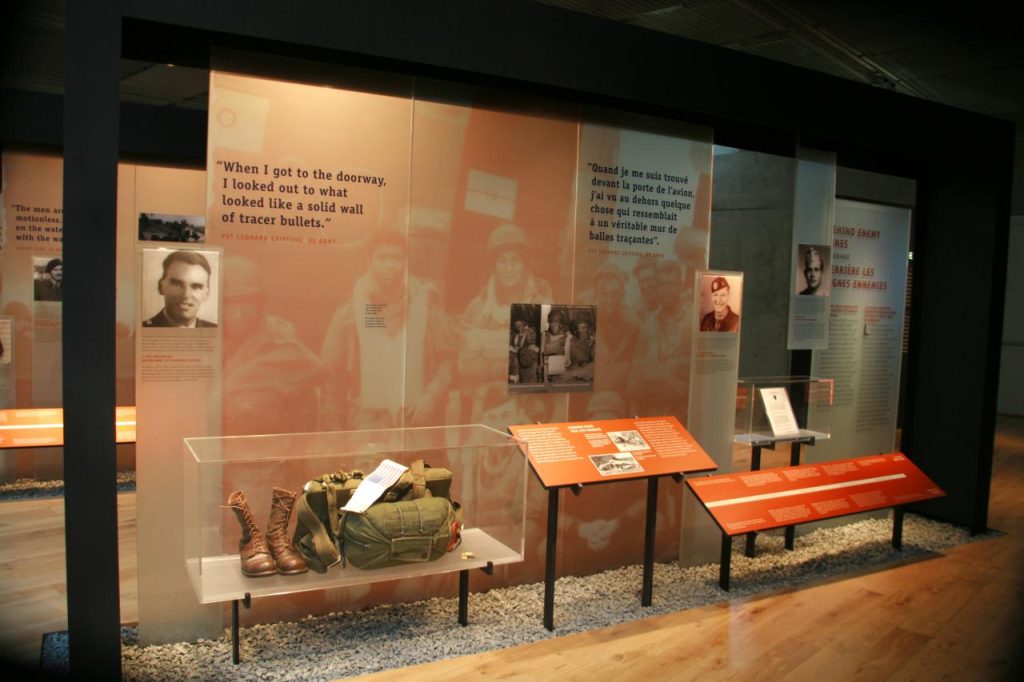EXHIBIT DESIGNER: Gallagher & Associates, Bethesda, MD
The interpretive exhibits at the Normandy American Cemetery Visitor Center complement and enrich the experience of visiting the cemetery. They accomplish this key goal by connecting the strategic developments of Operation Overlord with stories of individual men and women that made it happen. The focus on personal experiences underscores the importance of each individual headstone within the cemetery. Constructing a balanced narrative, the exhibit intersperses stories from various service branches and military units from the American forces and its allies. Through the layered presentation of major themes and historical data, the exhibit reaches out to various audiences: those visitors with memories of the global conflict, those who have a personal connection with Normandy invasion, and younger generations who may be learning about the events surrounding D-Day for the first time.
The success of the Operation Overlord depended upon the competence, courage, and sacrifice of millions – military and civilian alike. An engraved quotation in the lobby from General Dwight D. Eisenhower makes this point, and articulates these three major themes that organize the exhibits. The architecture of the Visitor Center divides the exhibits between the lobby and lower level. The lobby provides an important overview that introduces the three major themes, linking each to a personal story. The adjacent American Battle Monuments Commission Gallery describes the organization that maintains this site and many others worldwide, honoring America’s fallen service men and women. Designed as a stand alone experience focused on the broad themes of the exhibit, the lobby is organized so visitors on a tight schedule can proceed directly out to the cemetery.
The lower level exhibits proceed in a roughly chronological manner through the three main galleries of Competence, Courage, and Sacrifice. Introductory exhibits and a theater on this level place Operation Overlord within a larger historical and geopolitical context, demonstrating how nothing less than democracy itself was at stake. An extended timeline begins here, with dates and events positioning D-Day within the course of global conflict.
The use of steel and glass as the main exhibit materials reinforces the enduring strength of these major themes and ideas. Large open steel structures frame and focus each of the key stories within the Competence and Courage Galleries. The steel structures in the Competence Gallery are rigidly arranged within the gallery’s architecture, suggesting the meticulous planning and preparation for Operation Overlord. The steel structures in the Courage Gallery are askew, referring to the changes – and even chaos – that occur when planning meets actual battlefield conditions. When plans fall short, courage and sacrifice restore balance.
The Competence Gallery contains a small audio theater reinforcing the focus on the individual by allowing visitors to hear the personal experiences of those involved. The Courage Gallery begins with a theater where visitors learn of the difficult decision Eisenhower made which ultimately launched the invasion. This gallery ends with a large projection of shifting images that carry the story from the beaches through the liberation of Paris.
In a carefully orchestrated transition, visitors quietly move through a gently sloping corridor where they hear names of those buried in the cemetery. They then enter the Sacrifice Gallery, a bright sunlit space surrounded by powerful stories etched into glowing glass panels. Each story bears the face of the story’s subject, set at eye height to make that poignant connection with the visitor before exiting out to the cemetery, the true focus of the visitor’s experience.
 An official website of the United States government. Here's how you know.
An official website of the United States government. Here's how you know. 
